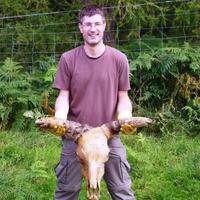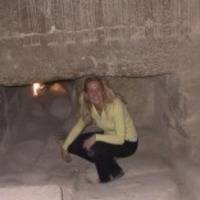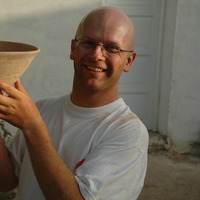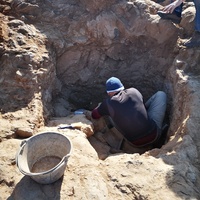
Lorna Tilley
Lorna Tilley is an independent researcher living in Australia who came late to bioarchaeology. She completed an honours degree in psychology at Flinders University (South Australia) and then worked in a range of public sector jobs, many dealing with aspects of health practice, health outcomes assessment and health policy development; this experience provided the foundation for her current work. Seeking a change in direction, she enrolled at the Australian National University (Canberra) and was awarded a PhD in archaeology in 2013. Lorna’s dissertation, which introduced the bioarchaeology of care and its instrument, the Index of Care, was published in 2015 as Theory and Practice in the Bioarchaeology of Care (the first volume in Springer’s Bioarchaeology and Social Theory series). She has since co-edited a volume on advances in the bioarchaeology of care approach (New Developments in the Bioarchaeology of Care: Further Case Studies and Extended Theory – Springer, 2017) and two Special Issues in the International Journal of Paleopathology on, respectively, Mummy studies and the bioarchaeology of care (2019) and Disability and care in Western Europe during Medieval times: a bioarchaeological perspective (2024). She has published a number of articles exploring application of the bioarchaeology of care methodology in different eras and under different conditions.
Phone: +61 (0)487 414941
Phone: +61 (0)487 414941
less
Related Authors
Richard Thomas
University of Leicester
Angel Fuentes
Universidad Autónoma de Madrid
Estella Weiss-Krejci
Austrian Academy of Sciences
Sandra Lösch
Bern University
Gary Feinman
Field Museum
Daniş Baykan
Trakya University
Anne Austin
University of Missouri - St. Louis
Bart Vanthuyne
Universität zu Köln
Leonardo García Sanjuán
Universidad de Sevilla
Eszter Banffy
Hungarian Academy of Sciences










Uploads
Papers by Lorna Tilley
Objective
To test the hypothesis that a bioarchaeological focus on health-related care provision can contribute to the currently limited understanding of social practice in Early Anglo-Saxon England (mid5th-early7th centuries AD).
Materials
Published descriptions of pathology in 69 adult remains from the Early Anglo-Saxon cemetery of Worthy Park, southern England.
Methods
Three case studies (one examining likely need for care at an individual level and two at a population level) were undertaken using the bioarchaeology of care approach.
Results
Analyses indicate likely care provision (‘direct support’ and/or ‘accommodation of difference’) to Worthy Park individuals experiencing temporary or permanent disability. Interpretation suggests community interdependence, cooperation, flexibility and tolerance of difference, as well as cultural and socioeconomic mechanisms for managing physical and social challenges of ageing.
Conclusions
This study provides proof of concept that bioarchaeology of care analysis can offer new insights into social practice in this period.
Significance
This study demonstrates that a bioarchaeological focus on caregiving behaviours in an Early Anglo-Saxon community extends modern thinking about social relations in post-Roman Britain, offering a model for future investigations into social practice in this, and potentially other, periods. More generally, it illustrates the richness of results achievable when combining bioarchaeological and historical research.
Limitations
Reliance on secondary sources limited detail (and potentially accuracy) of interpretation possible.
Suggestions for further research
This study’s approach should be further tested and refined, either through application to different Anglo-Saxon (or other historic) populations or in a more thorough analysis of the Worthy Park sample itself.
individual may have required based on the presence of paleopathological evidence. To date, all of the research
that has employed the framework has been based on evidence derived from skeletal material. This special issue
was organized in order to highlight how the analysis of mummified soft tissue, as well as other sources of data
commonly associated with mummified remains, such as coprolites and intestinal contents, has the potential to
provide valuable insight into the reconstruction of care in the past.
Objective
To test the hypothesis that a bioarchaeological focus on health-related care provision can contribute to the currently limited understanding of social practice in Early Anglo-Saxon England (mid5th-early7th centuries AD).
Materials
Published descriptions of pathology in 69 adult remains from the Early Anglo-Saxon cemetery of Worthy Park, southern England.
Methods
Three case studies (one examining likely need for care at an individual level and two at a population level) were undertaken using the bioarchaeology of care approach.
Results
Analyses indicate likely care provision (‘direct support’ and/or ‘accommodation of difference’) to Worthy Park individuals experiencing temporary or permanent disability. Interpretation suggests community interdependence, cooperation, flexibility and tolerance of difference, as well as cultural and socioeconomic mechanisms for managing physical and social challenges of ageing.
Conclusions
This study provides proof of concept that bioarchaeology of care analysis can offer new insights into social practice in this period.
Significance
This study demonstrates that a bioarchaeological focus on caregiving behaviours in an Early Anglo-Saxon community extends modern thinking about social relations in post-Roman Britain, offering a model for future investigations into social practice in this, and potentially other, periods. More generally, it illustrates the richness of results achievable when combining bioarchaeological and historical research.
Limitations
Reliance on secondary sources limited detail (and potentially accuracy) of interpretation possible.
Suggestions for further research
This study’s approach should be further tested and refined, either through application to different Anglo-Saxon (or other historic) populations or in a more thorough analysis of the Worthy Park sample itself.
individual may have required based on the presence of paleopathological evidence. To date, all of the research
that has employed the framework has been based on evidence derived from skeletal material. This special issue
was organized in order to highlight how the analysis of mummified soft tissue, as well as other sources of data
commonly associated with mummified remains, such as coprolites and intestinal contents, has the potential to
provide valuable insight into the reconstruction of care in the past.
This book presents the ‘bioarchaeology of care’ - a case study-based approach for identifying and interpreting disability and health-related care practices within the corresponding lifeways context that has the capacity to reveal elements of past social relations, socioeconomic organisation, and group and individual identity which might otherwise remain inaccessible. The bioarchaeology of care methodology (supported by the Index of Care, a freely-available web-based instrument found at www.indexofcare.com) contains four stages of analysis, each building on the content of preceding one(s); these consist of (i) description and diagnosis, (ii) assessment of disability impact and the corresponding case for care, (iii) derivation of a model of the care provided, and (iv) interpretation of the broader implications of the provision and receipt in relation to the subject receiving care and the social environment in which caregiving occurs.
Theory and Practice in the Bioarchaeology of Care is the primary source of information on this new approach, and serves as a manual for its implementation. It looks first at the way in which health-related caregiving has been treated in archaeological research, considering where, and why, this treatment has fallen short. Succeeding chapters establish the context and the conceptual foundations for undertaking bioarchaeological research into care provision, including defining and operationalising terminology surrounding ‘disability’ and ‘care’; examining debate around social and biological origins of healthcare, and considering the implications of this debate for addressing caregiving motivations and practice; and presenting a theoretical framework for exploring collective and individual decision-making processes involved in care provision. Two chapters then detail the four stages of the bioarchaeology of care methodology and application of the Index of Care. These are followed by three chapters demonstrating application of the bioarchaeology of care methodology in case studies exploring, respectively, health-related care given to Man Bac Burial 9 (Neolithic Vietnam), the Neandertals La Chapelle-aux-Saints 1 and La Ferrassie 1 (European Upper Middle Palaeolithic), and Lanhill Burial 7 (early British Neolithic), and illustrating the variety, richness and immediacy of insights attainable from a bioarchaeology of care analysis. Most importantly, these case studies confirm that a bioarchaeology of care focus on caregiving as an expression of both group and personal agency allows an engagement with the past that brings us closer to those who inhabited it. The final chapter discusses some future directions for bioarchaeology of care research, and considers how bioarchaeology of care research findings might inform modern values and practices.
Further Case Studies and Extended Theory
Lorna Tilley and Alecia Schrenk (Editors)
Springer International: Switzerland 2017
BOOK OVERVIEW
Only in the last five years has the topic of health-related care found acceptance as legitimate subject matter for archaeology. In 2011, a case study-based ‘bioarchaeology of care’, designed to provide a framework for identifying, analysing and interpreting evidence for likely disability and associated care response, was proposed; the approach generated academic and wider public interest, and from this time on it has continued to evolve as bioarchaeologists apply it to cases of likely caregiving and broader theoretical questions of care provision within their areas of specialisation.
New Developments in the Bioarchaeology of Care: Further Case Studies and Extended Theory marks an important milestone in this evolutionary process. Its origins lie in a symposium entitled ‘Building a Bioarchaeology of Care’, held during the Society for American Archaeology 2015 annual meeting, which brought together an international, cross-disciplinary group of scholars to explore this theme. This book contains 19 chapters, most based on symposium presentations, the first substantive chapter providing an overview of the bioarchaeology of care methodology and last situating the bioarchaeology of care approach, and the chapters in this book in particular, within the discipline of bioarchaeology more generally. The 16 chapters that comprise the core of this volume offer content which is always original, often methodologically innovative, and frequently challenging, and are organised under three headings. In the first section, Case studies: applying and adapting the bioarchaeology of care methodology, Chapters 2-9 focus primarily on the care given to one or more individuals who experienced (variously) a congenital disorder, acquired disease, accidental or intentional injury and who date to prehistory (Bronze Age, United Arab Emirates), through later Pre-Columbian (southern United Sates and Peru) and Mediaeval periods (United Kingdom and Poland), to relatively modern times (late 18th century London). These chapters also contribute to bioarchaeology of care theory, however, because each one, in some way, has implications for how we conceptualise past caregiving or for how we might improve current research methods. In the second section, New directions for bioarchaeology of care research, Chapters 10-16 explore alternative perspectives for illuminating past health-related care behaviours. Respectively, they address the scope for applying the bioarchaeology of care methodology to mummified remains; the potential for research into past caregiving to focus on demographic sectors of the population which are often overlooked - specifically children and the aged; the prospects for acknowledging psychological, spiritual and/or emotional forms of support in bioarchaeology of care studies; the modification of the bioarchaeology of care model to allow an assessment of institutional healthcare efficacy at both an individual and a population level; the development of a biocultural model for examining the origins of health-related caregiving; and the potential relevance for bioarchaeology of care studies of an online application supporting research into clinical and social implications of living with disease. In the third section, Ethics and accountability in the bioarchaeology of care, Chapter 17 interrogates the principles, assumptions, values and beliefs that are likely to influence carriage of bioarchaeology of care research, and Chapter 18 considers ethical responsibilities involved in communicating bioarchaeology of care research findings in the public domain, and discusses some practical ideas for information-sharing.
The Index of Care (www.indexofcare.org) is an on-line instrument for assisting researchers to 'think through' a bioarchaeology of care study. It contains four 'steps' corresponding to the bioarchaeology of care 'stages', and linked worksheets prompt consideration of relevant biological and archaeological variables; operationalise key concepts such as 'disability', 'care' and 'agency'; facilitate ordering and analysis of evidence; and encourage rigour and transparency in the research process. Published in 2014, the Index of Care has already been employed in many bioarchaeology of care studies.
This poster provides a quick guide to Index of Care application, and readers are invited to download it for use in their research and/or teaching. The authors would be grateful for any feedback.